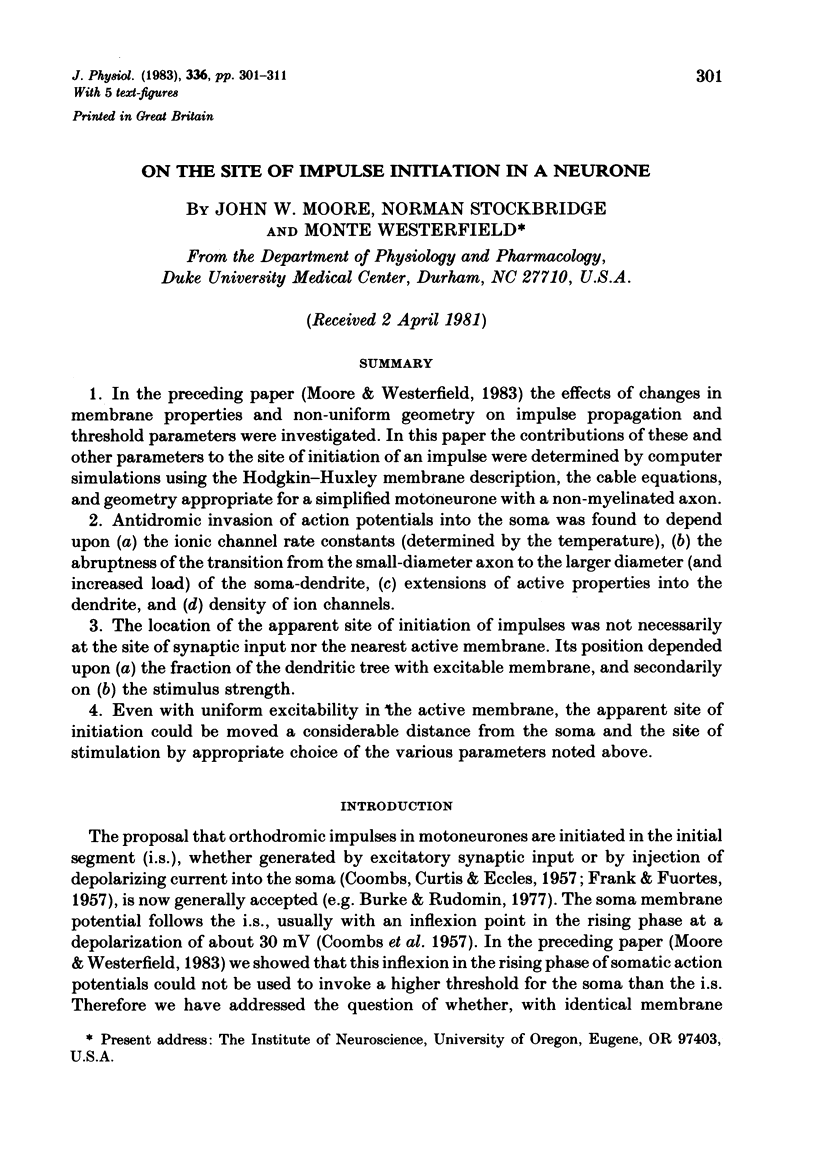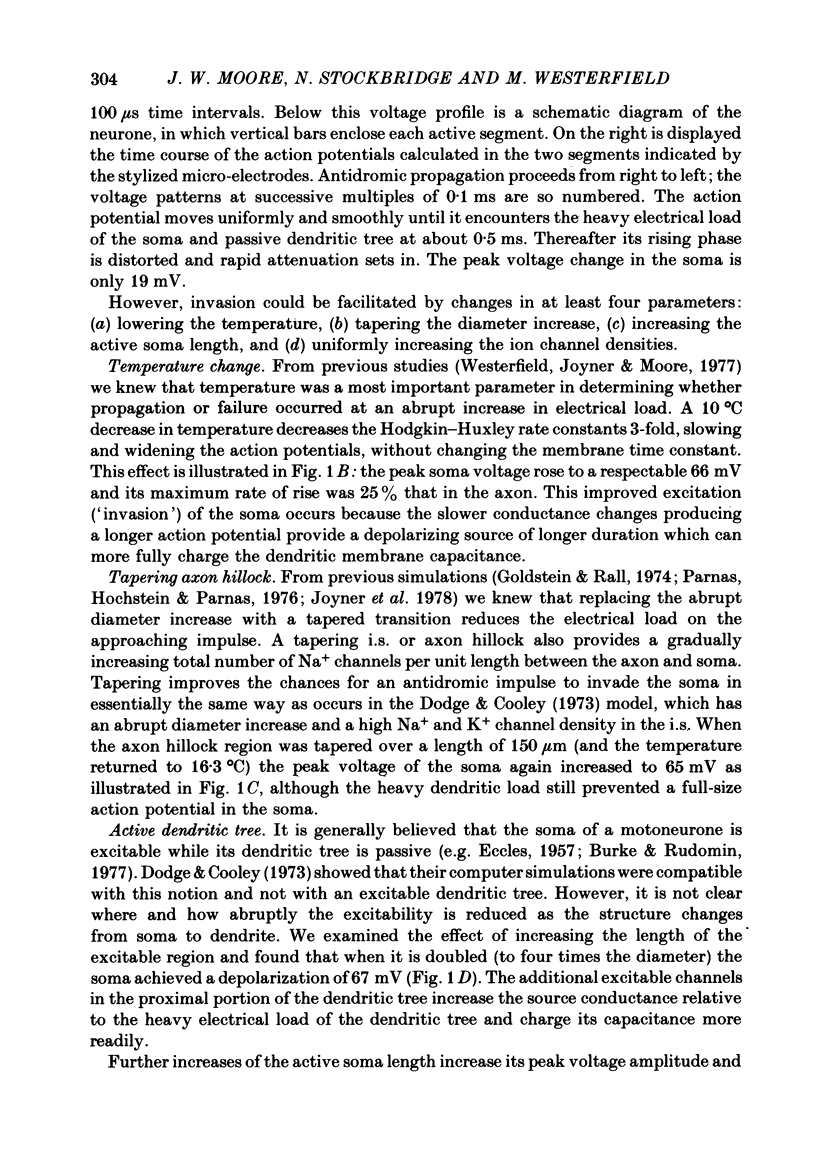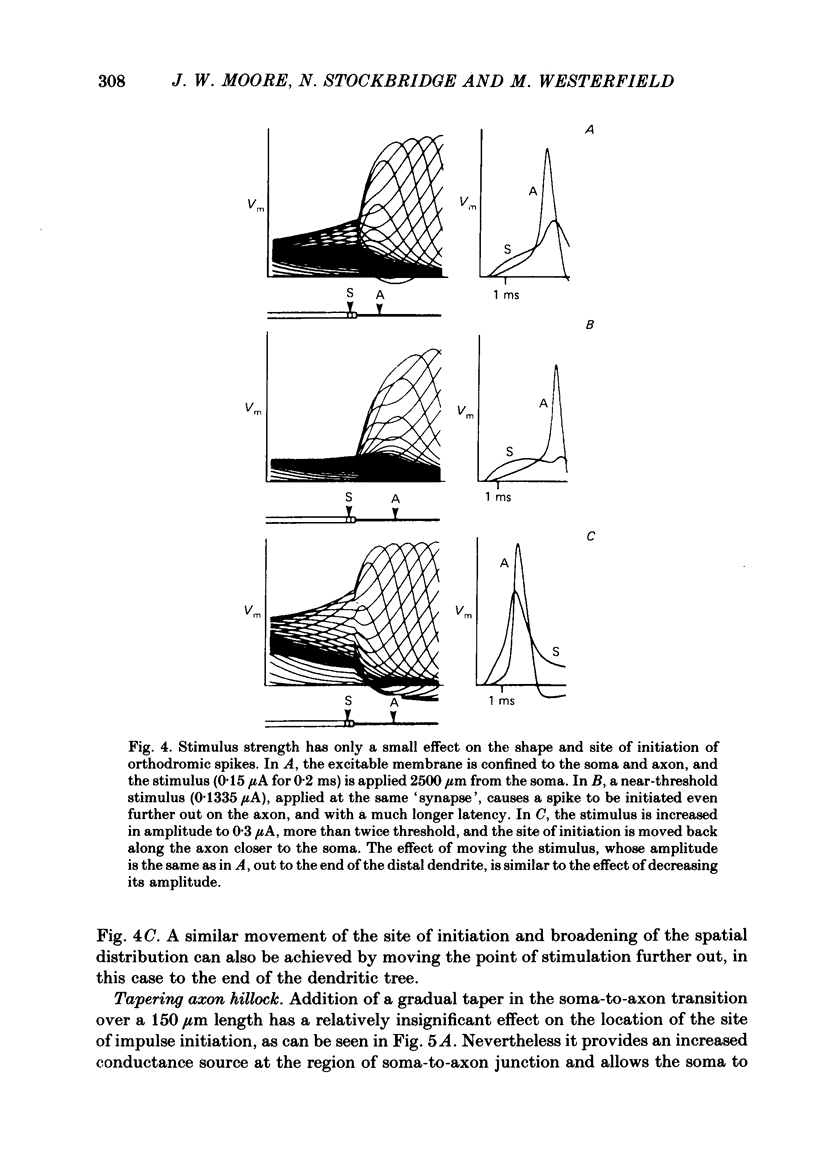Abstract
In the preceding paper (Moore & Westerfield, 1983) the effects of changes in membrane properties and non-uniform geometry on impulse propagation and threshold parameters were investigated. In this paper the contributions of these and other parameters to the site of initiation of an impulse were determined by computer simulations using the Hodgkin-Huxley membrane description, the cable equations, and geometry appropriate for a simplified motoneurone with a non-myelinated axon. Antidromic invasion of action potentials into the soma was found to depend upon (a) the ionic channel rate constants (determined by the temperature), (b) the abruptness of the transition from the small-diameter axon to the larger diameter (and increased load) of the soma-dendrite, (c) extensions of active properties into the dendrite, and (d) density of ion channels. The location of the apparent site of initiation of impulses was not necessarily at the site of synaptic input nor the nearest active membrane. Its position depended upon (a) the fraction of the dendritic tree with excitable membrane, and secondarily on (b) the stimulus strength. Even with uniform excitability in the active membrane, the apparent site of initiation could be moved a considerable distance from the soma and the site of stimulation by appropriate choice of the various parameters noted above.
Full text
PDF










Selected References
These references are in PubMed. This may not be the complete list of references from this article.
- Brill M. H., Waxman S. G., Moore J. W., Joyner R. W. Conduction velocity and spike configuration in myelinated fibres: computed dependence on internode distance. J Neurol Neurosurg Psychiatry. 1977 Aug;40(8):769–774. doi: 10.1136/jnnp.40.8.769. [DOI] [PMC free article] [PubMed] [Google Scholar]
- COOMBS J. S., CURTIS D. R., ECCLES J. C. The interpretation of spike potentials of motoneurones. J Physiol. 1957 Dec 3;139(2):198–231. doi: 10.1113/jphysiol.1957.sp005887. [DOI] [PMC free article] [PubMed] [Google Scholar]
- FRANK K., FUORTES M. G., NELSON P. G. Voltage clamp of motoneuron soma. Science. 1959 Jul 3;130(3366):38–39. doi: 10.1126/science.130.3366.38. [DOI] [PubMed] [Google Scholar]
- Goldstein S. S., Rall W. Changes of action potential shape and velocity for changing core conductor geometry. Biophys J. 1974 Oct;14(10):731–757. doi: 10.1016/S0006-3495(74)85947-3. [DOI] [PMC free article] [PubMed] [Google Scholar]
- HODGKIN A. L., HUXLEY A. F. A quantitative description of membrane current and its application to conduction and excitation in nerve. J Physiol. 1952 Aug;117(4):500–544. doi: 10.1113/jphysiol.1952.sp004764. [DOI] [PMC free article] [PubMed] [Google Scholar]
- Joyner R. W., Westerfield M., Moore J. W., Stockbridge N. A numerical method to model excitable cells. Biophys J. 1978 May;22(2):155–170. doi: 10.1016/S0006-3495(78)85481-2. [DOI] [PMC free article] [PubMed] [Google Scholar]
- Moore J. W., Joyner R. W., Brill M. H., Waxman S. D., Najar-Joa M. Simulations of conduction in uniform myelinated fibers. Relative sensitivity to changes in nodal and internodal parameters. Biophys J. 1978 Feb;21(2):147–160. doi: 10.1016/S0006-3495(78)85515-5. [DOI] [PMC free article] [PubMed] [Google Scholar]
- Moore J. W., Westerfield M. Action potential propagation and threshold parameters in inhomogeneous regions of squid axons. J Physiol. 1983 Mar;336:285–300. doi: 10.1113/jphysiol.1983.sp014581. [DOI] [PMC free article] [PubMed] [Google Scholar]
- Nelson P. G., Lux H. D. Some electrical measurements of motoneuron parameters. Biophys J. 1970 Jan;10(1):55–73. doi: 10.1016/S0006-3495(70)86285-3. [DOI] [PMC free article] [PubMed] [Google Scholar]
- Parnas I., Hochstein S., Parnas H. Theoretical analysis of parameters leading to frequency modulation along an inhomogeneous axon. J Neurophysiol. 1976 Jul;39(4):909–923. doi: 10.1152/jn.1976.39.4.909. [DOI] [PubMed] [Google Scholar]
- RALL W. Theory of physiological properties of dendrites. Ann N Y Acad Sci. 1962 Mar 2;96:1071–1092. doi: 10.1111/j.1749-6632.1962.tb54120.x. [DOI] [PubMed] [Google Scholar]
- Ramón F., Joyner R. W., Moore J. W. Propagation of action potentials in inhomogeneous axon regions. Fed Proc. 1975 Apr;34(5):1357–1363. [PubMed] [Google Scholar]
- Westerfield M., Joyner R. W., Moore J. W. Temperature-sensitive conduction failure at axon branch points. J Neurophysiol. 1978 Jan;41(1):1–8. doi: 10.1152/jn.1978.41.1.1. [DOI] [PubMed] [Google Scholar]


